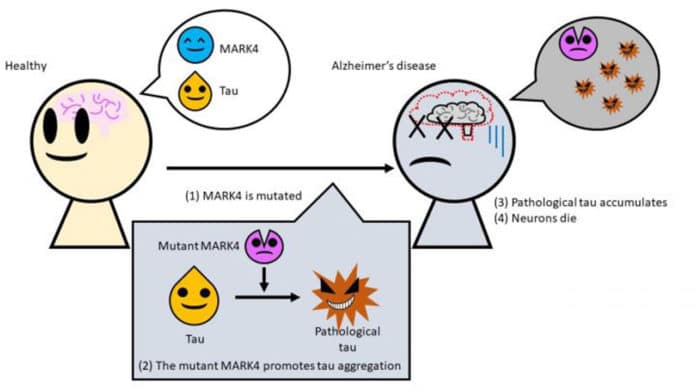Alzheimer’s disease is a devastating disease that begins with vague, often misinterpreted signs of mild memory loss followed by a slow, progressively severe decline in cognitive ability and quality of life. The disease is caused by the build-up of tangled clumps of a protein called “tau” in brain cells.
These clumps cause neurons to die, prompting impedance in memory and motor functions. It isn’t yet clear how and why tau develops in the brain cells of Alzheimer’s patients. Understanding the cause and mechanism behind this unwanted clumping would open up the best approach to new treatments and approaches to prevent the disease.
A team led by Associate Professor Kanae Ando of Tokyo Metropolitan University have discovered a new mechanism by which clumps of tau protein are created in the brain, killing brain cells and causing Alzheimer’s disease. Scientists explored the role played by the MARK4 (Microtubule Affinity Regulating Kinase 4) enzyme in Alzheimer’s disease.
To keep the cytoskeleton or microtubules’ arms always building and disassembling, MARK4 helps tau detach from this structure’s components.
The problem arises when a mutation occurs in the gene that provides the blueprint for making MARK4. A previous study on this- associated this with an increased risk of Alzheimer’s, but it was not known why this was the case.
For this study, scientists artificially introduced mutations into transgenic Drosophila fruit flies that also produce human tau. They then studied how the proteins changed in vivo.
They found that this mutant form of MARK4 changes the tau protein, creating a pathological form of tau. This bad tau aggregated much more quickly and were no longer soluble in detergents. This made it easier for tau to form the tangled clumps that cause neurons to degenerate.
MARK4 has also been found to cause a wide range of other diseases that involve the aggregation and buildup of different proteins. That’s why the team’s insights into tau protein buildup may lead to new treatments and preventative measures for an even wider variety of neurodegenerative conditions.
Journal Reference:
- Toshiya Oba et al. Microtubule Affinity Regulating Kinase 4 with an Alzheimer’s disease-related mutation promotes tau accumulation and exacerbates neurodegeneration. DOI: 10.1074/jbc.RA120.014420
